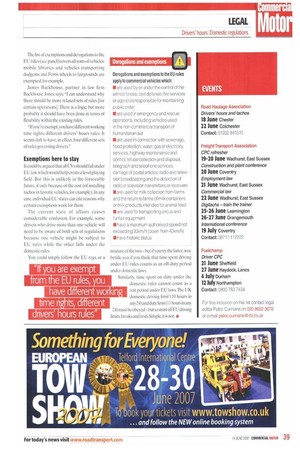British and proud of it
Page 38

Page 39

If you've noticed an error in this article please click here to report it so we can fix it.
Despite new EU drivers' rules, there are exempt operators still covered by domestic hours regulations. But what are these, and
who do they affect? Adam Hill reports.
In an age of increasing European Union legislation it is sometimes surprising to find regulations that are purely for those parts of the UK road transport industry which are exempt from EU rules. These rules are the domestic hours regulations.Those exemptions usually involve vehicles which are highly specialist, with their functions often being in the public interest rather than for reward.
EU Regulation 561/2006 amended 3821/85 and 2135/98 on drivers' records and replaced 3820/85 on drivers' hours. These new and amended laws came into force between May 2006 and April this year — but member states were allowed derogations permitting them to exempt specific vehicles or add further conditions to the concessions.
Not all operators will be aware of the scope of some of the new EU legs, particularly those that have been amended rather than added. Key changes include recovery vehicles— which now have to operate within a 100km radius of their base to be exempt.
Gary Hodgson, partner in charge of transport at Ford & Warren, asks: "How many recovery firms, especially the smaller ones, are aware they are in the fold [if they travel more than 100km away from base]?" The list of exemptions and derogations to the EU rules (see panel) covers all sorts of vehicles: mobile libraries and vehicles transporting dodgems and Ferris wheels to fairgrounds are exempted for example.
James Backhouse, partner in law firm Back house Jones, says: "I can understand why there should he more relaxed sets of rules [for certain operations]. There is a logic, but more probably it should have been done in terms of flexibility within the existing rules.
"If you're exempt, you have different working time rights, different drivers' hours rules. It seems daft to have, in effect, four different sets of rules governing drivers."
Exemptions here to stay
It could be argued that all CVs should fall under EU law, which would help create a level playing field. But this is unlikely in the forseeable future, if only because of the cost (of installing tachos in historic vehicles, for example). In any case, individual ELT states can cite reasons why certain exemptions work for them.
The current state of affairs causes considerable confusion. For example, some drivers who drive more than one vehicle will need to be aware of both sets of regulations because one vehicle might be subject to EU rules while the other falls under the domestic rules.
You could simply follow the EU regs, or a mixture of the two if you try the latter, woe betide you if you think that time spent driving under EU rules counts as an off-duty period under domestic laws.
Similarly, time spent on duty under the domestic rules cannot count as a rest period under EU laws .The UK domestic driving limit (10 hours in any 24) and duty limit (11 hours in any 24) must be obeyed—but so must all EU driving limits, breaks and rests. Sim ple,it is not. is


























































































































































































